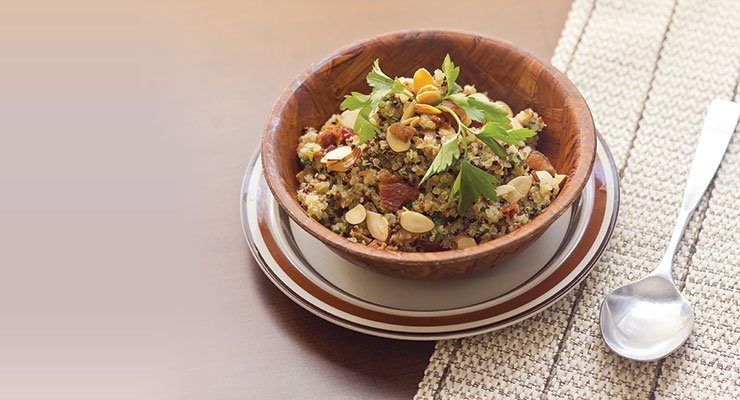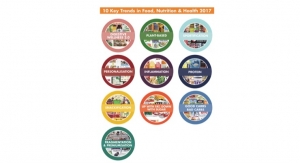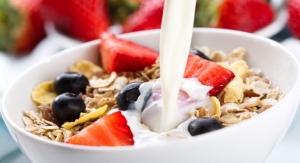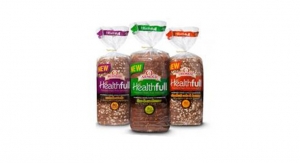Amanda Baltazar, Contributing Writer04.01.15
When General Mills started selling Cheerios + Ancient Grains in January, it was clear that a niche area of ingredients had reached the mainstream.
However, General Mills wasn’t the first big player to jump into this arena. Quaker’s Ancient Grains granola bars and Pepperidge Farm’s bread were already on the market.
Ancient grains—aptly named for their long history of traditional use—constitute a broad category that includes amaranth, farro, freekeh, spelt, barley, millet, teff and others. But what’s really helped catapult this category into the modern American family’s kitchen has been quinoa’s recent rise to stardom.
“Quinoa is gluten-free, it cooks quickly, it’s a source of complete protein, and protein seems to be always in vogue,” said Kelly Toups, program manager, The Whole Grains Council, Boston, MA. “It also has a great story behind it and people are more interested in where food comes from.”
“Consumers are trying to expand their repertoire on a daily basis,” said Melissa Abbott, vice president, culinary insights, The Hartman Group, Bellevue, WA. “Quinoa is the thing we’re stuck on right now but there’s no reason why another grain won’t come along and displace it; but it’s got to be easy and can’t disrupt the way we cook things.”
Deep-Rooted Growth
Ancient grains dovetail with many food trends, said Ms. Toups, and are listed as No. 13 on the National Restaurant Association’s (NRA) Top 20 Food Trends for 2015. They are minimally processed (No. 5 on the NRA’s list) and very nutritious (No. 17).
The mainstreaming of these grains is reflected by statistics from SPINS, a Chicago, IL-based firm that tracks the natural, specialty and organic food industries.
Last July SPINS reported the fastest growing sales of ancient grains were from Kamut (the brand name for khorasan wheat), whose sales grew 686% in the year ended July 13, 2014, followed by spelt (which increased by 363%) and freekeh (159%). For gluten-free grains, sales of amaranth climbed 123% and teff sales were up 58%.
Like quinoa, the other ancient grains offer a solid nutritional profile. But the main reason consumers are turning to many of these grains is growing interest in all things gluten-free. According to Datamonitor’s 2013 Global Consumer Survey, 13% of respondents worldwide said they are trying to avoid gluten, while another 26% said they’re trying to limit their intake. The NRA still lists gluten-free cuisine as No. 12 in its food trends for 2015, though it also said gluten-free foods were down 7% last year over 2013.
Many consumers are also more knowledgeable about nutrition these days, seeking foods that are less processed and naturally high in nutrients to get more bang for their food buck.
In fact, according to Datamonitor’s 2013 consumer survey, 46% of respondents said foods or beverages naturally high in nutrients are “very appealing.” This compares favorably with just 16% of consumers who feel products with added nutrients are “very appealing.”
The Hartman Group’s Ms. Abbott sees a fair amount of quinoa in the average person’s cupboard, “but interestingly they’re often buying it from foodservice or buying it in packaged goods, but not making it.”
Consumers are mostly baking with flour from ancient grains, especially teff and spelt, Ms. Abbott noted, because it’s the easiest way to incorporate them into the diet.
“People are thinking they want to get something out of their carbs and these grains are unrefined,” noted Wendy Esko, director, marketing research, Eden Foods, Clinton, MI.
Hot Product Trends
Bay State Milling, Quincy, MA, introduced ancient grain flours five years ago, beginning with spelt, and has seen sales grow “as a result of people wanting more nutrition from their gluten-free products,” said Colleen Zammer, director of marketing.
KIND Healthy Snacks, New York, NY, jumped on the ancient grains trend in 2011 with its Healthy Grains Clusters, which contain oats, quinoa, amaranth, buckwheat and millet. In March this year the company added a new line, Healthy Grains Popped, which also contain sorghum.
The company incorporated these so-called “super grains” to boost the fiber in its products, according to Jon Lesser, director of marketing. Each product has at least 18 grams of whole grains per serving.
“Consumers are so busy in their daily life that they don’t have time to cook these ingredients and we want them to be able to fit them into their daily life,” said Mr. Lesser.
Sweet Earth Natural Foods, Moss Landing, CA, has a line of eight frozen burritos, which contain ancient grains in their fillings, as well as four new “functional burritos” with whole-wheat tortillas that also include flaxseed and oat bran.
Each burrito features a different grain. For example, the Peruvian variety contains quinoa while the Anasazi uses barley. The company’s veggie burgers (which are sold fresh in refrigerated cases) also feature ancient grains: barley and quinoa in the Teriyaki and Santa Fe; bulgur, quinoa and farro in the Za’atar.
The hottest grains right now, according to Sweet Earth Natural Foods Owner and CEO Kelly Swette, are quinoa, brown rice, farro (which she said has good texture, a nutty flavor and holds its shape for visual appeal) and millet (which also holds its shape, has visual appeal and a little bite).
Sweet Earth’s ancient grain products have particular traction with Millennials “because they’re interested in more plant-based foods, are natural explorers and interested in global experiences,” said Ms. Swette. Older consumers, especially those who are heart healthy “are also looking for the benefit of complex grains.”
Schär, Lyndhurst, NJ, has been using ancient grains in its products since launching in the U.S. in 2008, using mostly buckwheat, lupine and millet. “Now we are looking to our R&D team to develop new and creative ways to increase our product line,” said Dr. Anne Lee, director of nutritional services.
Hot grains include millet, amaranth, quinoa, chia, “and what’s exciting to me as a nutritionist is these are amazing grains from a nutritional profile and they add so much more value to the food,” she said.
Schär’s products add ancient grains to breads, pasta and table crackers, though the breads are the company’s best sellers. “These are an easy way to incorporate grains into our diets,” said Dr. Lee.
During the processing of ancient grains into flour some vitamins and fiber are lost, though minerals remain intact, she added.
However, eating these foods with some loss of nutrients is better than the alternative: highly processed white flours.
What’s Next?
New Cheerios + Ancient Grains contain quinoa, Kamut and spelt, which is a good indication of some grains that are hot right now. But what’s next?
Tom Vierhile of Datamonitor Consumer, New York, NY, predicted the next big ancient grains will be millet, sorghum, farro, bulgur, teff and freekeh, especially farro and bulgur, “as they are being blended with more familiar ancient grains like quinoa.”
Amaranth is another ancient grain that could break out, he noted, since it is similar to quinoa, “but it doesn’t seem to be showing the same signs of commercial acceptance as other ancient grains.”
Amaranth, quinoa, millet and spelt are leading sales growth at Bay State Milling, said Ms. Zammer. “Even if the flour is made up of less than 1% of the grain, people just love to see quinoa on a label and relate it to high nutrition.”
However, the popularity of these grains may work against them. “The inclusion of these grains in products and brands widely perceived as processed is likely to make things less clear-cut going forward,” she warned.
Still, the surface of the ancient grain trend has only been scratched. “We are only seeing very common varieties of amaranth, quinoa and millet; each grain has many different varieties, which also vary in color. The more colorful the grain, the more nutritious it is, as those colors are from antioxidant compounds that naturally protect the plant. There are many ancient wheat varieties, such as emmer, einkorn and red fife, that are also poised for growth.”
Dr. Lee, from Schär, predicted spelt sales will continue to grow, even though it contains gluten, because it is high in calcium and iron. Seeds from hemp, pumpkin and flax are also positioned for success, she noted. “We’ll see grains and seeds used in more interesting applications. The cracker aisle is full of products with ancient grains and I think that will expand into main meals and sweet cookies.”
Sweet Earth’s Ms. Swette suggested Kamut, teff and amaranth will gain the spotlight moving forward, though the latter two are tiny and thus hard for consumers to use. “The bigger grains offer so much more diversity because texture and visual appeal make a difference,” she said.
However, General Mills wasn’t the first big player to jump into this arena. Quaker’s Ancient Grains granola bars and Pepperidge Farm’s bread were already on the market.
Ancient grains—aptly named for their long history of traditional use—constitute a broad category that includes amaranth, farro, freekeh, spelt, barley, millet, teff and others. But what’s really helped catapult this category into the modern American family’s kitchen has been quinoa’s recent rise to stardom.
“Quinoa is gluten-free, it cooks quickly, it’s a source of complete protein, and protein seems to be always in vogue,” said Kelly Toups, program manager, The Whole Grains Council, Boston, MA. “It also has a great story behind it and people are more interested in where food comes from.”
“Consumers are trying to expand their repertoire on a daily basis,” said Melissa Abbott, vice president, culinary insights, The Hartman Group, Bellevue, WA. “Quinoa is the thing we’re stuck on right now but there’s no reason why another grain won’t come along and displace it; but it’s got to be easy and can’t disrupt the way we cook things.”
Deep-Rooted Growth
Ancient grains dovetail with many food trends, said Ms. Toups, and are listed as No. 13 on the National Restaurant Association’s (NRA) Top 20 Food Trends for 2015. They are minimally processed (No. 5 on the NRA’s list) and very nutritious (No. 17).
The mainstreaming of these grains is reflected by statistics from SPINS, a Chicago, IL-based firm that tracks the natural, specialty and organic food industries.
Last July SPINS reported the fastest growing sales of ancient grains were from Kamut (the brand name for khorasan wheat), whose sales grew 686% in the year ended July 13, 2014, followed by spelt (which increased by 363%) and freekeh (159%). For gluten-free grains, sales of amaranth climbed 123% and teff sales were up 58%.
Like quinoa, the other ancient grains offer a solid nutritional profile. But the main reason consumers are turning to many of these grains is growing interest in all things gluten-free. According to Datamonitor’s 2013 Global Consumer Survey, 13% of respondents worldwide said they are trying to avoid gluten, while another 26% said they’re trying to limit their intake. The NRA still lists gluten-free cuisine as No. 12 in its food trends for 2015, though it also said gluten-free foods were down 7% last year over 2013.
Many consumers are also more knowledgeable about nutrition these days, seeking foods that are less processed and naturally high in nutrients to get more bang for their food buck.
In fact, according to Datamonitor’s 2013 consumer survey, 46% of respondents said foods or beverages naturally high in nutrients are “very appealing.” This compares favorably with just 16% of consumers who feel products with added nutrients are “very appealing.”
The Hartman Group’s Ms. Abbott sees a fair amount of quinoa in the average person’s cupboard, “but interestingly they’re often buying it from foodservice or buying it in packaged goods, but not making it.”
Consumers are mostly baking with flour from ancient grains, especially teff and spelt, Ms. Abbott noted, because it’s the easiest way to incorporate them into the diet.
“People are thinking they want to get something out of their carbs and these grains are unrefined,” noted Wendy Esko, director, marketing research, Eden Foods, Clinton, MI.
Hot Product Trends
Bay State Milling, Quincy, MA, introduced ancient grain flours five years ago, beginning with spelt, and has seen sales grow “as a result of people wanting more nutrition from their gluten-free products,” said Colleen Zammer, director of marketing.
KIND Healthy Snacks, New York, NY, jumped on the ancient grains trend in 2011 with its Healthy Grains Clusters, which contain oats, quinoa, amaranth, buckwheat and millet. In March this year the company added a new line, Healthy Grains Popped, which also contain sorghum.
The company incorporated these so-called “super grains” to boost the fiber in its products, according to Jon Lesser, director of marketing. Each product has at least 18 grams of whole grains per serving.
“Consumers are so busy in their daily life that they don’t have time to cook these ingredients and we want them to be able to fit them into their daily life,” said Mr. Lesser.
Sweet Earth Natural Foods, Moss Landing, CA, has a line of eight frozen burritos, which contain ancient grains in their fillings, as well as four new “functional burritos” with whole-wheat tortillas that also include flaxseed and oat bran.
Each burrito features a different grain. For example, the Peruvian variety contains quinoa while the Anasazi uses barley. The company’s veggie burgers (which are sold fresh in refrigerated cases) also feature ancient grains: barley and quinoa in the Teriyaki and Santa Fe; bulgur, quinoa and farro in the Za’atar.
The hottest grains right now, according to Sweet Earth Natural Foods Owner and CEO Kelly Swette, are quinoa, brown rice, farro (which she said has good texture, a nutty flavor and holds its shape for visual appeal) and millet (which also holds its shape, has visual appeal and a little bite).
Sweet Earth’s ancient grain products have particular traction with Millennials “because they’re interested in more plant-based foods, are natural explorers and interested in global experiences,” said Ms. Swette. Older consumers, especially those who are heart healthy “are also looking for the benefit of complex grains.”
Schär, Lyndhurst, NJ, has been using ancient grains in its products since launching in the U.S. in 2008, using mostly buckwheat, lupine and millet. “Now we are looking to our R&D team to develop new and creative ways to increase our product line,” said Dr. Anne Lee, director of nutritional services.
Hot grains include millet, amaranth, quinoa, chia, “and what’s exciting to me as a nutritionist is these are amazing grains from a nutritional profile and they add so much more value to the food,” she said.
Schär’s products add ancient grains to breads, pasta and table crackers, though the breads are the company’s best sellers. “These are an easy way to incorporate grains into our diets,” said Dr. Lee.
During the processing of ancient grains into flour some vitamins and fiber are lost, though minerals remain intact, she added.
However, eating these foods with some loss of nutrients is better than the alternative: highly processed white flours.
What’s Next?
New Cheerios + Ancient Grains contain quinoa, Kamut and spelt, which is a good indication of some grains that are hot right now. But what’s next?
Tom Vierhile of Datamonitor Consumer, New York, NY, predicted the next big ancient grains will be millet, sorghum, farro, bulgur, teff and freekeh, especially farro and bulgur, “as they are being blended with more familiar ancient grains like quinoa.”
Amaranth is another ancient grain that could break out, he noted, since it is similar to quinoa, “but it doesn’t seem to be showing the same signs of commercial acceptance as other ancient grains.”
Amaranth, quinoa, millet and spelt are leading sales growth at Bay State Milling, said Ms. Zammer. “Even if the flour is made up of less than 1% of the grain, people just love to see quinoa on a label and relate it to high nutrition.”
However, the popularity of these grains may work against them. “The inclusion of these grains in products and brands widely perceived as processed is likely to make things less clear-cut going forward,” she warned.
Still, the surface of the ancient grain trend has only been scratched. “We are only seeing very common varieties of amaranth, quinoa and millet; each grain has many different varieties, which also vary in color. The more colorful the grain, the more nutritious it is, as those colors are from antioxidant compounds that naturally protect the plant. There are many ancient wheat varieties, such as emmer, einkorn and red fife, that are also poised for growth.”
Dr. Lee, from Schär, predicted spelt sales will continue to grow, even though it contains gluten, because it is high in calcium and iron. Seeds from hemp, pumpkin and flax are also positioned for success, she noted. “We’ll see grains and seeds used in more interesting applications. The cracker aisle is full of products with ancient grains and I think that will expand into main meals and sweet cookies.”
Sweet Earth’s Ms. Swette suggested Kamut, teff and amaranth will gain the spotlight moving forward, though the latter two are tiny and thus hard for consumers to use. “The bigger grains offer so much more diversity because texture and visual appeal make a difference,” she said.
























